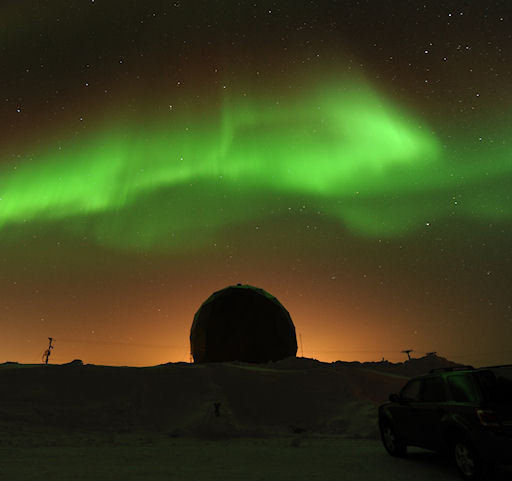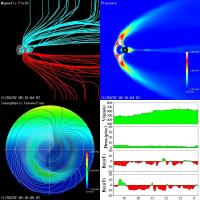| Iceland - 800 earthquakes in one day |
1 Mar 11 - This website reports 800 earthquakes in one day on Iceland's Reykjanes Peninsula, while another reports 400 earthquakes in one day.
With all of this seismic activity, they worry that the Krísuvík volcanic system (also spelled Krysuvik) could soon erupt.
It does sound worrisome at first, but when I look at the Iceland Met Office website, I see that activity has slowed dramatically.
I think I'll wait a bit before I go into panic mode. Besides, I don't know what would be considered normal for that part of Iceland.
Thanks to Laurel and Wanda for these links.
| Krísuvík volcanic system |
| "Several eruptions have taken place since the settlement of Iceland, including the eruption of a large lava flow from the Ogmundargigar crater row around the 12th century," says the Smithsonian website. "The latest eruption at Krísuvík took place during the 14th century." (In the year 1188, according to John Search's Volcano Live website.) See http://www.volcano.si.edu/world/volcano.cfm?vnum=1701-03= |
Largest earthquake in 35 years hits ArkansasLINK
The U.S. Geological Survey recorded the quake at 11 p.m. Sunday, centered just northeast of Greenbrier, about 40 miles north of Little Rock. It was the largest of more than 800 quakes to strike the area since September in what is now being called the Guy-Greenbrier earthquake swarm.
The activity has garnered national attention and researchers are studying whether there's a possible connection to the region's natural gas drilling industry. The earthquake activity varies each week, though as many as nearly two dozen small quakes have occurred in a day.
"You don't know what to expect. It's unnerving," said Corinne Tarkington, an employee at a local flower and gift shop. "I woke up last night to the sound of my house shaking."
What woke Tarkington was a magnitude 4.7 earthquake that was also felt in Oklahoma, Missouri, Tennessee and Mississippi. No injuries or major damage have been reported, but the escalation in the severity of quakes in and around the small north-central Arkansas town has many residents on edge. Some said they're seeing gradual damage to their homes, such as cracks in walls and driveways.
"We probably had 40 to 50 calls last night," Greenbrier police Sgt. Rick Woody said, noting that the tone of the calls had changed. After pervious quakes, most callers simply wanted to find out if a loud noise they'd heard was an earthquake, he said.
"The fear had calmed down until last night," Woody said Monday. "People's biggest concerns (now) are whether or not these earthquakes are going to get any bigger."
Scott Ausbrooks, seismologist for the Arkansas Geological Survey, said Sunday's record quake was at the "max end" of what scientists expect to happen, basing that judgment on this swarm and others in the past. It's possible that a quake ranging from magnitude 5.0 to 5.5 could occur, but anything greater than that is highly unlikely, he said.
Ausbrooks said he plans to hold a town hall meeting in Greenbrier next month to address people's concerns.
"This quake actually scared folks," he said. "It lasted longer than a lot of the others did."
Ausbrooks said scientists continue to study whether there may be a connection between the earthquakes and local injection wells, where the natural gas industry pumps waste water that can no longer be used by drillers for hydraulic fracturing. Fracturing, or "fracking," involves injecting pressurized water to create fractures deep in the ground to help free the gas.
Geologists don't believe the fracturing is the problem, but possibly the injection wells.
A major source of the state's natural gas is the Fayetteville Shale, an organically-rich rock formation in north-central Arkansas. A six-month moratorium was established in January on new injection wells in the area to allow time to study the relationship - if any - between the wells and the earthquakes.
In Greenbrier, many residents are starting to notice gradual damage. Tarkington said her house has started to show cracks in ceilings and walls.
"You can see the wear and tear on our houses," she said. "I wish they'd go away."
Taylor Farrell, 29, a Greenbrier resident and employee at a local flea market, said a large crack formed in her driveway several months ago, and as the earthquakes continue, the crack has spread into her garage.
She said she and her husband had removed everything from the walls of their house, including family photos and television sets, because many photos had fallen in recent quakes.
"Other than that, there's really not much more you can do," she said. "It's Mother Earth. It's going to do what it's going to do. All we can do is wait for the big one and hope and pray it doesn't happen."
Read more: http://www.kansascity.com/2011/02/28/2689334/largest-earthquake-in-35-years.html#ixzz1FROQ21Jv
Scientists warn of more intense future snowstorms as climate unravels
 March 2, 2011 – JAPAN – Climate change is not only making the planet warmer, it is also making snowstorms stronger and more frequent, US scientists said on Tuesday. “Heavy snowstorms are not inconsistent with a warming planet,” said scientist Jeff Masters, as part of a conference call with reporters and colleagues convened by the Union of Concern Scientists. “In fact, as the Earth gets warmer and more moisture gets absorbed into the atmosphere, we are steadily loading the dice in favor of more extreme storms in all seasons, capable of causing greater impacts on society.” Masters said that the northeastern United States has been coated in heavy snowfall from major Category Three storms or larger three times in each of the past two winters, storms that are unparalleled since the winter of 1960-61. “If the climate continues to warm, we should expect an increase in heavy snow events for a few decades, until the climate grows so warm that we pass the point where it’s too warm for it to snow heavily.” Mark Serreze, director of the National Snow and Ice Data Center in Boulder, Colorado, said less sea ice in the Artic translates to more moisture in the atmosphere, and could also cause an atmospheric circulation pattern in polar regions known as Arctic Oscillation. “It’s still cutting-edge research and there’s no smoking gun, but there’s evidence that with less sea ice, you put a lot of heat from the ocean into the atmosphere, and the circulation of the atmosphere responds to that,” Serreze said. –Breitbart
March 2, 2011 – JAPAN – Climate change is not only making the planet warmer, it is also making snowstorms stronger and more frequent, US scientists said on Tuesday. “Heavy snowstorms are not inconsistent with a warming planet,” said scientist Jeff Masters, as part of a conference call with reporters and colleagues convened by the Union of Concern Scientists. “In fact, as the Earth gets warmer and more moisture gets absorbed into the atmosphere, we are steadily loading the dice in favor of more extreme storms in all seasons, capable of causing greater impacts on society.” Masters said that the northeastern United States has been coated in heavy snowfall from major Category Three storms or larger three times in each of the past two winters, storms that are unparalleled since the winter of 1960-61. “If the climate continues to warm, we should expect an increase in heavy snow events for a few decades, until the climate grows so warm that we pass the point where it’s too warm for it to snow heavily.” Mark Serreze, director of the National Snow and Ice Data Center in Boulder, Colorado, said less sea ice in the Artic translates to more moisture in the atmosphere, and could also cause an atmospheric circulation pattern in polar regions known as Arctic Oscillation. “It’s still cutting-edge research and there’s no smoking gun, but there’s evidence that with less sea ice, you put a lot of heat from the ocean into the atmosphere, and the circulation of the atmosphere responds to that,” Serreze said. –Breitbart
Posted in Earth Changes, Earth Watch, Extreme Weather Event 2 Comments
NASA to set-up camera network across U.S. to triangulate fireballs

March 2, 2011 – Every day about 100 tons of meteoroids — fragments of dust and gravel and sometimes even big rocks – enter the Earth’s atmosphere. Stand out under the stars for more than a half an hour on a clear night and you’ll likely see a few of the meteors produced by the onslaught. But where does all this stuff come from? Surprisingly, the answer is not well known. Now NASA is deploying a network of smart cameras across the United States to answer the question, What’s Hitting Earth? Did that meteor you saw blazing through the sky last night come from the asteroid belt? Was it created in a comet’s death throes? Or was it a piece of space junk meeting a fiery demise? “When I get to work each morning and power up my computer, there’s an email waiting with answers,” says William Cooke, head of NASA’s Meteoroid Environment Office. “And I don’t have to lift a finger, except to click my mouse button.” Groups of smart cameras in the new meteor network triangulate the fireballs’ paths, and special software1 uses the data to compute their orbits and email Cooke his morning message. ”If someone calls me and asks ‘What was that?’ I’ll be able to tell them. We’ll have a record of every big meteoroid that enters the atmosphere over the certain parts of the U.S. Nothing will burn up in those skies without me knowing about it!” In other U.S. meteor networks, someone has to manually look at all the cameras’ data and calculate the orbits – a painstaking process. “With our network, our computers do it for us – and fast,” says Cooke. The network’s first three cameras, each about the size of a gumball machine, are already up and running. Cooke’s team will soon have 15 cameras deployed east of the Mississippi River, with plans to expand nationwide2. Cooke is actively seeking schools, science centers, and planetaria willing to host his cameras. Criteria are listed in the notes at the end of this story. -Physics.org
Posted in 2012, Earth Changes, Earth Watch, Space Watch Leave a comment
Sunburn: Solar wind from coronal hole blast planet Earth

March 2, 2011 - MAGNETIC STORM IN PROGRESS: A solar wind stream hit Earth’s magnetic field during the early hours of March 1st. The impact sparked a geomagnetic storm that was, at first, minor, but the storm has been intensifying throughout the day. Spotters are now reporting auroras over Northern Ireland, Scotland, Latvia, Norway, and Sweden. If trends continue, the display could spread to the high latitudes of North America after nightfall. Stay tuned! -Space Weather
Well, we said this was a nasty hole rotating towards the planet. Solar wind speeds have revved up to 638 km/sec. We’re on the watch for the eruption of flares with this present sunspot cluster. Below the planet magnetosphere is hit with a burn blast from the rabid flow of the solar wind stream.



No comments:
Post a Comment
Note: only a member of this blog may post a comment.